
|
The Society of Folk Dance Historians (SFDH)
Romanian Folk Music Instruments
[
Home |
About |
Encyclopedia | CLICK AN IMAGE TO ENLARGE |

|
The people of Romania have always known how to make use of the simplest and unexpected means in expressing their marvelous artistical creations. A leaf, a blade of grass, a fish scale, a piece of birch bark, a perforated coin, a thin paper and comb, or a piece of celluloid are capable of conveying into sounds the feelings working within the folk artist's soul.
HARPA EVREILOR
 Besides the simple ones, there are the musical instruments, some of them still rudimentary, such as the harpa evreilor (jew's harp): a small horseshoe shaped instrument, usually about 5 to 9 inches long, to the middle of which a thin bent metal tongue is fixed; when placed between the teeth, its vibrations caused by striking the metal tongue with the finger are intensified and modulated in the performer's mouth. One can meet performers who master this musical instrument with virtuosity.
Besides the simple ones, there are the musical instruments, some of them still rudimentary, such as the harpa evreilor (jew's harp): a small horseshoe shaped instrument, usually about 5 to 9 inches long, to the middle of which a thin bent metal tongue is fixed; when placed between the teeth, its vibrations caused by striking the metal tongue with the finger are intensified and modulated in the performer's mouth. One can meet performers who master this musical instrument with virtuosity.
FIFĂ
![]() The Romanian people's ingenuity has created numberless kinds of pipes along the centuries. They form a real family, consisting of several members! The simplest one is the fifă (fife); a wooden pipe, about 2 to 5 inches long, open at both ends, and having no openings for the fingers. The tilincă is held in a slightly tilting position and is blown by pursing one's lips a little, so that the air column is split by the somewhat thinned edge of the end. This instrument – the simplest of pipes that one can imagine – is very uncommon. It can produce various sounds after the way it is blown, soft or hard, as well as by regulating the opposite end of the pipe with the finger. It is almost unbelievable that on such a more than rudimentary instrument one could play, and sometimes with great art too.
The Romanian people's ingenuity has created numberless kinds of pipes along the centuries. They form a real family, consisting of several members! The simplest one is the fifă (fife); a wooden pipe, about 2 to 5 inches long, open at both ends, and having no openings for the fingers. The tilincă is held in a slightly tilting position and is blown by pursing one's lips a little, so that the air column is split by the somewhat thinned edge of the end. This instrument – the simplest of pipes that one can imagine – is very uncommon. It can produce various sounds after the way it is blown, soft or hard, as well as by regulating the opposite end of the pipe with the finger. It is almost unbelievable that on such a more than rudimentary instrument one could play, and sometimes with great art too.
TILINCĂ
![]() The tilincă is held in a slightly tilting position and is blown by pursing one's lips a little, so that the air column is split by the somewhat thinned edge of the end. This instrument – the simplest of pipes that one can imagine – is very uncommon. It can produce various sounds after the way it is blown, soft or hard, as well as by regulating the opposite end of the pipe with the finger. It is almost unbelievable that on such a more than rudimentary instrument one could play, and sometimes with great art too, lays, songs, and jigs.
The tilincă is held in a slightly tilting position and is blown by pursing one's lips a little, so that the air column is split by the somewhat thinned edge of the end. This instrument – the simplest of pipes that one can imagine – is very uncommon. It can produce various sounds after the way it is blown, soft or hard, as well as by regulating the opposite end of the pipe with the finger. It is almost unbelievable that on such a more than rudimentary instrument one could play, and sometimes with great art too, lays, songs, and jigs.
On the various kinds of pipes, the shepherds chiefly play tunes connected with their occupation, such as "Setting off," "On the sheep starting down the valley,: The herd a-grazing," the ditty of "The shepherd having lost his sheep," as well as various lays, songs, and jigs. To their tunes they sometimes dance, especially at offhand șezătoare (gatherings).
FLUIER
![]() In the northern part of Moldavia, the fluier is open at both ends, just like the tilincă, and is 14 to 20 inches long. Six holes for the fingers are cut in the pipe, however, and by covering or leaving them open, the length of the sound tube is shortened or lengthened, thus enabling sounds of various heights to be produced.
In the northern part of Moldavia, the fluier is open at both ends, just like the tilincă, and is 14 to 20 inches long. Six holes for the fingers are cut in the pipe, however, and by covering or leaving them open, the length of the sound tube is shortened or lengthened, thus enabling sounds of various heights to be produced.
In Dobrugea, similar pipes are sometimes used, usually made of reed. They have, however, seven holes for the fingers, the seventh being cut on the opposite side of the tube, above the others.
The most widespread pipe is the one having a stopper and six opening for the fingers. The end to blow at is stopped by a "cork" with a narrow rectangular slot in it. The air blast blown by the performer into this slot is split and caused to vibrate by the thinned edge of an opening cut into the tube wall, not far from the stopper.
FLUIER GEMĂNAT
![]() A variant of the fluier is the fluier gemănat (gemănat means twin) or twinned pipe, 14 to over 20 inches long. Alongside the usual tube another one is affixed, with a stopper to it but having no holes for the fingers, as long as or half the length of the former. This causes the tune performed on the former to be always accompanied by a "pedal" (the same sound kept up longer).
A variant of the fluier is the fluier gemănat (gemănat means twin) or twinned pipe, 14 to over 20 inches long. Alongside the usual tube another one is affixed, with a stopper to it but having no holes for the fingers, as long as or half the length of the former. This causes the tune performed on the former to be always accompanied by a "pedal" (the same sound kept up longer).
CAVAL
![]() The caval is a large pipe, 23 to 35 inches long, with a stopper to it and five openings for the fingers. It is open and used in Oltenia and Wallachia.
The caval is a large pipe, 23 to 35 inches long, with a stopper to it and five openings for the fingers. It is open and used in Oltenia and Wallachia.
In some parts of Oltenia, they also play on folk flutes. The opening for blowing is placed on the side of the tube and has six or seven openings for the fingers.
BUCIUM
![]() The highlands often echo with the grave and penetrating sound of the bucium (alphorn), an ancient shepherd's instrument, usually 5 to 10 feet long, known to Romanians from the remotest times. Of old it was also used for military signaling. Folk tradition recollects to this day the part played by this instrument in the peasant's uprisings in Transylvania.
The highlands often echo with the grave and penetrating sound of the bucium (alphorn), an ancient shepherd's instrument, usually 5 to 10 feet long, known to Romanians from the remotest times. Of old it was also used for military signaling. Folk tradition recollects to this day the part played by this instrument in the peasant's uprisings in Transylvania.
The shepherds call it a bucium, bucin, trâmbiță (trumpet), or tulnic (bugle), and is usually made of long lags (staves) of firewood, platan, ash, linden, fir, or hazel.
The staves are obtained by cleaving the dried wood lengthwise and hollowing it. The two halves are then joined, glued together, and tied closely either by binding the whole length with birch, lime, or cherry bark, or with broom hoops.
On the South and East slopes of the Carpathian Mountains, in the Maramureș, Oaș, and Apuseni Mountains, various kinds of bucium can be met with, differing by the shape of the sound pipes.
In the North of the country, the bucium are often made of tin. The tulnic of the Apuseni Mountains, with its straight tapering pipe is always made of fir staves, bound with broom hoops. An interesting detail is that it is chiefly blown by girls and young women to playing various jigs< or reels or to give diverse signals.
Being a genuine woodwind instrument, the bucium produces a smaller or greater number of harmonics of the fundamental sounds in accordance with the length and shape of the sound tube as well as with the performer's skill.
The chief productions of the bucium are the shepherds' signals varying from one region to another, such as "the sheep's," "the sheep going up the mountain," "on making the fresh goat milk cheese," "the morning'un," etc., such tunes as the shepherds enjoy during their everyday labor. The bucium is often blown at funerals, especially at some shepherd's death.
NAI
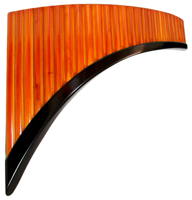 The most widespread as well as the most cherished Romanian folk music instrument is the nai (panpipe). There is hardly a village the does not hear its melody. The love of the Romanian people for the nai is reflected in some of the old legends and fairy tales, where the nai is often attributed miraculous powers.
The most widespread as well as the most cherished Romanian folk music instrument is the nai (panpipe). There is hardly a village the does not hear its melody. The love of the Romanian people for the nai is reflected in some of the old legends and fairy tales, where the nai is often attributed miraculous powers.
During the 20th century the nai was becoming less common with very few players continuing between the world wars. The most important remaining musician was Fănică Luca, Merited Artist of Romania, who began teaching a new generation of musicians with the Bărbu Lautaru folk orchestra in 1949 then at the Școala Medie de Muzică, din București (Secondary School of Music from Bucharest) from 1953. His most famous pupil being musician Gheorghe Zamfir.
The nai is an instrument that has always roused admiration by the brilliance of the Romanian musician's performance. It consists of a concave row of elder or reed pipes, varying in length. The pipes are stopped at the bottom and rest on a curved thin rod.
From seven or eight as it had two centuries ago, the number of pipes has increased to twenty-five and even thirty. As early as the second half of the last century the nai began to become scarce in Moldavia. Nowadays, it can rarely be found here and there with some musicians in Bucareșt and other towns, as well as in a few villages of Oltenia and Wallachia, along the Olt River banks.
The performer lays the bunch of pipes with open ends to his lips and blows into them. By variously tilting the pipes, the sound can be slightly raised or lowered. The nai sound is clear and strong and its timbre is a bright one.
The natural pitch of a each pipe can can be adjusted to give the chromatics by inclining the instrument toward the musician which allows sliding notes.
CIMPOI
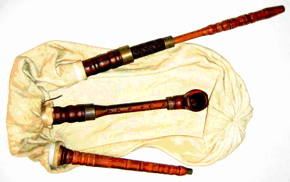 The Romanians have known the cimpoi (bagpipe) for a long time. Religious writings mention it as early as the 15th century, while old time chroniclers told of princes reveling in its tunes or of court weddings where pipers used to play their instruments wrapped in a sort of very expensive Italian velvet. At princely courts as well as in boyars' (members of the highest rank of the feudal Romanian nobility) houses the cimpoi was replaced by various instruments brought from alien places, chiefly owing to the increasing Ottoman influence and the penetration of the Levantine morals among the Romanian ruling classes. Despite the long lapse of time, the Romanian people have preserved it and so they still find it in several regions of Romania.
The Romanians have known the cimpoi (bagpipe) for a long time. Religious writings mention it as early as the 15th century, while old time chroniclers told of princes reveling in its tunes or of court weddings where pipers used to play their instruments wrapped in a sort of very expensive Italian velvet. At princely courts as well as in boyars' (members of the highest rank of the feudal Romanian nobility) houses the cimpoi was replaced by various instruments brought from alien places, chiefly owing to the increasing Ottoman influence and the penetration of the Levantine morals among the Romanian ruling classes. Despite the long lapse of time, the Romanian people have preserved it and so they still find it in several regions of Romania.
The cimpoi consists of an airbag made of goatskin, into which the air is blown through a tube provided with a leather valve inside, aimed at preventing the air blown in by the performer to escape through the same tube. By pressing the bag that is held under the arm of the performer, the air is forced out through two pipes: a longer one without an opening for the fingers, usually called a bîzói (droner), emitting a continuous low droning sound, and a smaller one, with several holes for the fingers, (six, seven, or eight) on which the tune is played. The smaller pipe, usually called the caraba (little whistle), is the chief part of the instrument.
The various types of cimpoi are characterized by their shapes (cylindrical of conical, single or double) and by the number and disposition of the holes for the fingers. At least five types of cimpoi are currently known.
It appears that of old, the dances in Romanian villages were performed to the tunes of cimpoi and pipes. Nowadays, in some villages of Oltenia, Bihor, and Hunedoara, the custom of the cimpoi was preserved, especially "when old people feel like having a good time." Not long ago, the cimpoi was inseparable from wedding feasts, chiefly in Wallachia, Oltenia, and Hunedoara regions.
COBZĂ
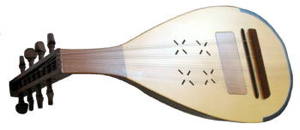 Among the Romanian popular stringed instruments, the oldest appears to be the cobză (lute). Its existence is mentioned as early as the 16th century.
Among the Romanian popular stringed instruments, the oldest appears to be the cobză (lute). Its existence is mentioned as early as the 16th century.
ȚAMBAL
 The musicians in the villages of Oltenia, Wallachia, and Dobrogea, as well as those in the Southern part of Moldavia, use to play on a small țambal (cimbalom), which they carry suspended by a leather strap passed about their necks, while they strike the strings with two ciocane (hammers), the ends of which are wrapped in cloth in order to soften the sounds. The musicians in villages usually play on a large țambal.
The musicians in the villages of Oltenia, Wallachia, and Dobrogea, as well as those in the Southern part of Moldavia, use to play on a small țambal (cimbalom), which they carry suspended by a leather strap passed about their necks, while they strike the strings with two ciocane (hammers), the ends of which are wrapped in cloth in order to soften the sounds. The musicians in villages usually play on a large țambal.
The țambal was first mentioned to be a part of the Romanian musician's bands in the second half of the 18th century.
Like the cobză, the țambal is a musician's instrument for accompaniment. Many musicians are, however, able to perform melodies on it with great skill.
VIOARĂ
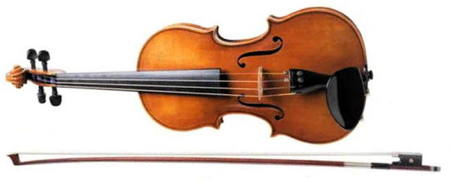 The vioră (violin), "of firewood birth in the village of mirth" as it is called, has long since taken its place among the musical instruments used by the Romanian people. It is to be met with everywhere, almost inseparable from Romanian musicians. It is known throughout the country under various names cittern, cetera, lute, lauta, fiddle, scripea, etc.
The vioră (violin), "of firewood birth in the village of mirth" as it is called, has long since taken its place among the musical instruments used by the Romanian people. It is to be met with everywhere, almost inseparable from Romanian musicians. It is known throughout the country under various names cittern, cetera, lute, lauta, fiddle, scripea, etc.
In some parts of the country it is provided with five to seven extra strings, stretched under the usual ones. Though the performer does not touch them with his bow, they resound "by sympathy" with the others and so amplify the resonance of kindred sounds. At other times, the usual accord is "spoiled" in order to facilitate the execution of some melody or to obtain outstanding sound effects.
TARAGOT
 Recently, the taragot (a sort of saxophone) has begun to be replaced by the saxaphone, especially in the Caransebeș region, where one can find proficient performers on this instrument, which they use in a quite characteristic popular style of execution.
Recently, the taragot (a sort of saxophone) has begun to be replaced by the saxaphone, especially in the Caransebeș region, where one can find proficient performers on this instrument, which they use in a quite characteristic popular style of execution.
ACCORDEON
BUHAI
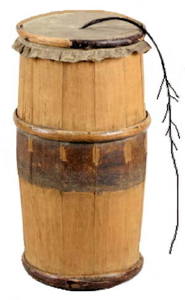 Ancient customs have still preserved a few instruments of the drum family. There is the bruhai (ox), a friction drum consisting of a wooden vessel, such as a wooden tub, bucket or barrel, the mouth of which is covered with a skin membrane with a strand of horse tail hair "ox tail" passing through its center. By pulling alternately at the strand with the wet hands, a sort of untuned oxen bellow is produced.
Ancient customs have still preserved a few instruments of the drum family. There is the bruhai (ox), a friction drum consisting of a wooden vessel, such as a wooden tub, bucket or barrel, the mouth of which is covered with a skin membrane with a strand of horse tail hair "ox tail" passing through its center. By pulling alternately at the strand with the wet hands, a sort of untuned oxen bellow is produced.
With the pipe or another instrument, it usually provides the sound background for the ritual plugușorul (little plough) on New Year's Day that tells in humorous verses of an allegorical form everything in field labor.
DOBE
 In the Western part of the country (the Hunedoara region, neighboring places in Transylvania and Banat), groups of carol singers singing on Christmas Eve occasionally sing carols of greeting, make use of a sort of dobe (a two-skinned drum) that they use to accompany their voices. They are small drums, about 10 inches in diameter, with two skin membranes spread on each side of a wooden ring, about four or five inches broad. The membranes are tied to each other with hemp string. They are struck with a stick.
In the Western part of the country (the Hunedoara region, neighboring places in Transylvania and Banat), groups of carol singers singing on Christmas Eve occasionally sing carols of greeting, make use of a sort of dobe (a two-skinned drum) that they use to accompany their voices. They are small drums, about 10 inches in diameter, with two skin membranes spread on each side of a wooden ring, about four or five inches broad. The membranes are tied to each other with hemp string. They are struck with a stick.
TOBĂ
 The tobă is a big drum, with a 2 1/2 feet diameter, and has only one membrane. Inside it is provided with several metal discs or squares strung on a string or on one of several wires stretched from side to side.
The tobă is a big drum, with a 2 1/2 feet diameter, and has only one membrane. Inside it is provided with several metal discs or squares strung on a string or on one of several wires stretched from side to side.
The performers beat it with the hand or the convex side of a wooden spoon.
DOCUMENTS
- Romania, a country.
- Romania's Călușarii, an article.
- Romanian Dance and Music, an article.
- Romanian Folklore, an article.
- Romanian Folk Dance and Culture, an article.
- Romanian Pipes of Pan, an article.
- Ron LaFarge, an article.
Excerpts from Rosin the Bow, Vol. 5, No. 9, Autumn 1955.
This page © 2018 by Ron Houston.
Please do not copy any part of this page without including this copyright notice.
Please do not copy small portions out of context.
Please do not copy large portions without permission from Ron Houston.

